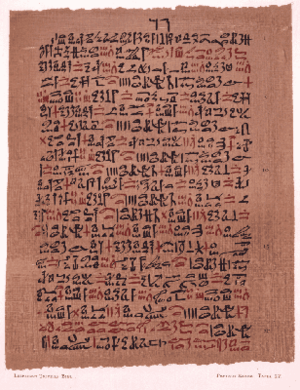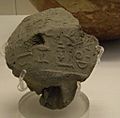Egyptian language facts for kids
Quick facts for kids Egyptian |
|||||||
|---|---|---|---|---|---|---|---|
ϯⲙⲉⲧⲣⲉⲙⲛ̀ⲭⲏⲙⲓ (Coptic) |
|||||||
| Region | Originally, throughout Ancient Egypt and parts of Nubia; (especially, during the times of the Nubian kingdoms); now, only, in several parts of Cairo and several villages, in Upper Egypt | ||||||
| Ethnicity | Ancient Egyptians, Copts | ||||||
| Era | Late fourth millennium BC – 19th century AD (with the extinction of Coptic); still used as the liturgical language of the Coptic Orthodox and Coptic Catholic churches and spoken, colloquially, by two families of Copts | ||||||
| Language family |
Afro-Asiatic
|
||||||
| Dialects |
Upper? †
Lower? †
|
||||||
| Writing system | hieroglyphs, cursive hieroglyphs, hieratic, demotic and Coptic (later, occasionally, Arabic script in government translations and Latin script in scholars' transliterations and several hieroglyphic dictionaries) | ||||||
| Linguasphere | 11-AAA-a | ||||||

Ebers Papyrus detailing treatment of asthma
|
|||||||
The Egyptian language was an Afroasiatic language spoken in Ancient Egypt. It was used for writing for about 5,000 years. This makes it one of the oldest known written languages in the world!
The Coptic language is like the modern version of the Egyptian language. It changed over time to become Coptic. Today, Copts use Coptic for religious purposes. Only a few people still speak Coptic fluently.
Older versions of the Egyptian language couldn't be understood for a long time. This changed when the Rosetta Stone was found in 1799. The Rosetta Stone has the same message written in three different languages. One of these languages was already known, which helped experts figure out the others.
The oldest records of the Egyptian language are from about 3400 BC. People spoke Egyptian, in its Coptic form, until the late 1600s. Today, the main language in Egypt is Egyptian Arabic. It took the place of Coptic in daily life after a major historical event where a new group took control of Egypt.
History of the Egyptian Language
Experts divide the Egyptian language into six main time periods. These periods show how the language changed and developed:
- Archaic Egyptian (before 2600 BC): This was the language used during Egypt's very early dynasties.
- Old Egyptian (2686 BC – 2181 BC): This was the language of the famous Old Kingdom, when the big pyramids were built.
- Middle Egyptian (2055 BC – 1650 BC): This language was used during the Middle Kingdom. It continued to be used in writing until the 4th century AD.
- Late Egyptian (1069 BC – 700 BC): This period started earlier, around 1353 BC, during the Amarna period.
- Demotic (7th century BC – 5th century AD): This form of Egyptian was used from the Late period through Roman times.
- Coptic (1st century AD – 17th century AD): This is the latest form of the language. It was spoken from early Roman times until the early modern period.
Early Egyptian writing, like labels and signs, dates back to 3200 BC. These first texts are called "Archaic Egyptian." In 1999, Archaeology Magazine reported that the earliest Egyptian glyphs (symbols) are from 3400 BC. This suggests that complex writing might have started in Egypt even before Mesopotamia.
Old Egyptian was spoken for about 500 years, starting around 2600 BC. Middle Egyptian was then spoken for another 700 years, starting around 2000 BC. Late Egyptian appeared after that. Middle Egyptian continued to be used in writing for many centuries, much like Latin was used in Europe during the Middle Ages.
Demotic Egyptian first appeared around 650 BC. It was spoken until the 5th century AD. Coptic Egyptian appeared in the 4th century AD. It was a living language until the 16th century AD. European scholars traveled to Egypt during the Renaissance to learn it from people who spoke it. Coptic likely continued to be spoken in the countryside for even longer. The Bohairic dialect of Coptic is still used by Egyptian Christian Churches today.
Old, Middle, and Late Egyptian were all written using hieroglyphs and hieratic script. Demotic was written using a script that came from hieratic. It looks a bit like modern Arabic script and is also written from right to left. Coptic is written using the Coptic alphabet. This alphabet is a changed version of the Greek alphabet. It includes some symbols from Demotic for sounds that weren't in ancient Greek.
Arabic became the language of Egypt's government after the Arab conquest in the 7th century AD. Over time, Arabic replaced Coptic as the language spoken by most people. Today, Coptic is still used as the liturgical language (for religious services) by the Coptic Orthodox Church and the Coptic Catholic Church.
Some words and names in the Bible are thought by scholars to be Egyptian in origin. For example, Zaphnath-Paaneah was an Egyptian name given to Joseph.
Images for kids
-
A 10th-century stone slab (stela) with Coptic writing, found in the Louvre museum.
See also
 In Spanish: Lenguas egipcias para niños
In Spanish: Lenguas egipcias para niños



